|
===================================================
How To Break 80 Newsletter
May 9, 2007
"The Web's Most Popular Golf Improvement
Newsletter"
===================================================
In this issue we'll discuss...
1) Mastering The Greenside Bunker Shot
2) Don't Cross Your Heart to Add Distance
3) Question of the Week- Chipping It Close
4) Article- Tale of Two Putters
5) Article- Perfecting Your Chip Shots
6) Article- Crush Your Drives...And Keep It In Play
===================================================
1) Mastering The Greenside Bunker Shot
===================================================
Ever hit one of those "home run" bunker shots? You know. The shot not only clears the lip of the bunker but also the far side of the green. If you have, you know it's far from the ideal way of getting out of a bunker. But you can eliminate home run bunker shots by remembering to use the reverse release. Slicing the ball out of the sand is the accepted technique with a greenside bunker shot. But since you usually rotate the clubface closed on standard shots, you can have problems with this approach because you need to hold the clubface open through impact. If you fail to rotate the clubface open sufficiently, you'll hit one of those home run bunker shots or something worse, costing you strokes. You can avoid this by starting with the standard bunker set up, in which the body is slightly open to the target, then
*Open your clubface
*Position the ball slightly forward
*Keep your body open to the target
*Swing the club along your bodyline
*Rotate your palm open (reverse release)
Ideally, you want the ball to fly out of the sand and land softly on the green. To achieve this, you need to use a slice swing, one that travels on an outside-to-in swing path, with the clubhead held open in relation to the path. Most players can make a slice swing fairly easily. The problem occurs with palm rotation. Coming down you should feel your right palm (left palm for left-handers) start rotating toward the sky. It should continue rotating open as the club slides through the sand and under the ball. This full rotation of the palm is what's referred to as the reverse release. It enables you to slide the clubface through the sand at impact and under the ball.
To avoid hitting a home run bunker shot, rotate your right palm open when hitting out of a greenside bunker. Rotating your palm through impact throws the ball out of the sand and settles it softly on the green.
Television Note:
PGA Tour Science of Golf will present two one-hour programs focusing on how modern technology has impacted the game of golf. The programs will put the full swing under scrutiny. Presented by BM, in High Definition, the first segment--Power Game--airs May19th (2:00PM to 3:00PM). The second segment--Short Game--airs May 27th (2:00PM to 3:00 PM) CBS Sports. PGA Tour Productions produced the programs. Give them a watch...I know I will.
==================================================
2) Don't Cross Your Heart to Add Distance
==================================================
Increasing clubhead speed adds distance to your shots. The faster your clubhead moves through impact zone, farther you'll hit the ball. Increase your club head speed, and you'll increase the distance of your shots. If you're wondering how to do that, look no further than the first two feet of your backswing. That's the key better ballstriking. Unfortunately, many weekend golfers don't strike the ball well because they don't take a full shoulder turn, as I've mentioned before. Instead, they drag the clubhead back while they keep the shoulders in place, resulting in an abbreviated turn. Dragging the clubhead also pulls the arms away from the body on the downswing, producing a weak, powerless over-the-top swing. Combined, these two moves inhibit ball striking, short-circuiting power. But you can remember to make a full shoulder turn by keeping a simple thought in mind: Don't let your arms cross you heart during the takeaway. If they do, the arms are moving independently of the torso. The left arm (right arm for left-handers) should be below the center of your chest until the club moves higher than your hips. By that point, much of the shoulder turn has occurred. The arms can then swing the club upward to complete the backswing.
Mirror Drill
Here's drill to help you learn the feel of a good shoulder turn without leaving your home. Take a normal address position, with your back to a mirror. Place your hands on top of your hips. Now turn to the right (left for left-hander), as if you were looking at someone directly behind you. At this point, you should feel both the torsion and the rotation of your spine that this simple move creates. Now, take a look in the mirror behind you. See how your back faces the target? Your shoulders will have turned at least 90 degrees and your hips about 45 degrees. Your left knee will be pointing inward and your weight will be mostly on your right side. This position is a crucial. You don't want to move outside of your footwork. Work on this drill frequently. Once you've engrained the feeling of a full shoulder turn, try hitting shots. You'll be amazed at how much better your ballstriking is and how much farther the ball goes--all the result of increasing your clubhead speed and preventing your arms from crossing your heart.
=================================================== 3)
Question of the Week- Chipping It Close
===================================================
From Mario Begin
Chipping It Close
Q. Hi. I would like some tips on how to chip from between 10 to 40 yards to the pin. What's the easiest way to do it? What drills will help me improve my chipping. It's the worst part of my game. Help!
A. Thanks for the question, Mario. It's a good one because chipping from between 10 to 40 yards is critical to playing well. When faced with a short chip shot, club choice is key. Ideally, you want to use a club based on how far the ball rolls on the green, and then let the club's loft do the work. The idea is to let the ball run to the hole like a putt. The clubs of choice for this shot are the 7, 8, 9, PW, and SW.
Five tips on chipping it close to the pin are:
1. Aim for a flat landing spot
2. Consider the green's condition
3. Decide on the required loft
4. Use less lofted clubs for uphill shots
5. Match the swing to the club
Your address position depends on the club. Before choosing it, consider the lie, condition of the putting surface, and the green's speed. Also consider the wind, slope, and grain of the green. Once you selected the club, aim for a flat spot on either the green or the fringe, and let the ball run to the hole. In general, the higher the club's loft, the shorter the roll. The farther you're away from the pin, the more roll you need. Some players like to use a less lofted club with an uphill lie. Others like to use a more lofted club with a downhill lie. Swing a little harder with a more lofted club.
A good drill for chipping it close is hitting chip shots with different clubs from various distances around the green. Just drop some balls and hit away. This drill isn't complicated, but it helps develop a feel for the roll you can expect with each club.
Keep practicing this drill until you have a good feel for the club's roll. Once you do, you'll find yourself chipping the ball closer and closer to the pin, and cutting strokes from your scores.
If you've got a golf question you'd like answered, send an email to us at
questions@howtobreak80.com and we'll review it. I can't guarantee that we'll use it but if we do, we'll make sure to include your name and where you're from.
===================================================
If you want to truly discover the secrets of shooting like the Pros and creating a more reliable and consistent swing, check out:
http://www.HowToBreak80.com
P.S. Feel free to share this newsletter with family and friends. If you
would like to subscribe to this newsletter, send a blank email to
break80ezine@aweber.com
===================================================
About the Author
===================================================
Jack Moorehouse is the author of the best-selling book
"How To Break 80 and
Shoot Like the Pros!". He is NOT a golf pro, rather a working man that has helped thousands of golfers from all seven continents lower their handicaps quickly. His free weekly newsletter goes out to thousands of golfers worldwide and provides the latest golf tips, strategies, techniques and instruction on how to improve your golf game.
|
Tools To
Help Your Game!
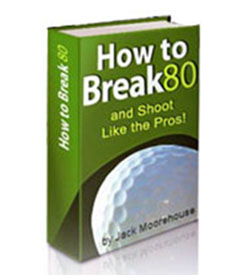
eBook
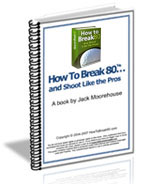
Physical Book
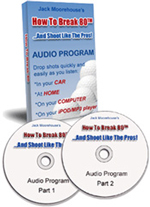
Audio Program
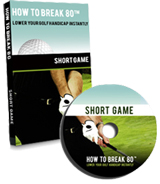
Short Game DVD
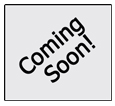
Driver DVD
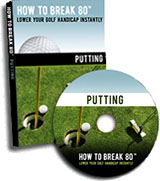
|